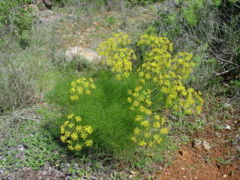Foeniculum
| Foeniculum subsp. var. | ||||||||||||||||||||||||||||||||||||||||||||||||||||||||
|---|---|---|---|---|---|---|---|---|---|---|---|---|---|---|---|---|---|---|---|---|---|---|---|---|---|---|---|---|---|---|---|---|---|---|---|---|---|---|---|---|---|---|---|---|---|---|---|---|---|---|---|---|---|---|---|---|

|
|
| ||||||||||||||||||||||||||||||||||||||||||||||||||||||
| ||||||||||||||||||||||||||||||||||||||||||||||||||||||||
Foeniculum is a genus of fewer than half a dozen species, in the family Apiaceae (Umbelliferae).
It is best known for Fennel (Foeniculum vulgare), treated by some botanists as the sole species in the genus. The name of the genus is derived from Latin feniculum, fœniculum, diminutive of fenum, fœnum, "hay".
| Standard Cyclopedia of Horticulture |
|---|
|
Foeniculum (diminutive from the Latin for hay, because of its odor). Umbelliferae. About four species of annual, biennial and perennial herbs, spread from the Canaries to W. Asia, one being the Fennel of gardens (which see). Glabrous, often tall: lvs. pinnately decompound, the segms. linear or filiform: fls. yellow, in compound umbels, the calyx-teeth obsolete, the petals broadish, emarginate: fr. oblong or ellipsoidal, not laterally compressed, the carpels half-terete, ribbed and flattened. F. vulgare, Hill (F. officinale, All. F. foeniculum, Karst.), of S. Eu., the fennel, is a perennial of short duration, cult, as an annual or biennial for its aromatic seeds and lvs.: erect and branched, 3-5 ft.: lvs. 3-4 times pinnate, the ultimate segms. very narrow and thread-like and rather stiff in the wild and in dry places but very slender when cult., the petioles broad and clasping: umbels large, of 15-20 or more rays. Often run wild.—Under cult., the petiole has become broad and sheathing and other changes have taken place. What are considered to be horticultural forms have been described as distinct species: var. piperitum, Hort. (F. piperitum, DC.), the carosella of S. Italy, the young sts. of which, inclosed in the sheathing petioles, are eaten raw in the early season; var. dulce, Alef. (F. dulce, Mill.), the finocchio or Florence fennel, a low-growing condensed plant, with very large lf .-bases. CH
|
Cultivation
- Do you have cultivation info on this plant? Edit this section!
Propagation
- Do you have propagation info on this plant? Edit this section!
Pests and diseases
- Do you have pest and disease info on this plant? Edit this section!
Species
Gallery
If you have a photo of this plant, please upload it! Plus, there may be other photos available for you to add.
-
photo 1
-
photo 2
-
photo 3
References
- Standard Cyclopedia of Horticulture, by L. H. Bailey, MacMillan Co., 1963
External links
- w:Foeniculum. Some of the material on this page may be from Wikipedia, under the Creative Commons license.
- Foeniculum QR Code (Size 50, 100, 200, 500)
